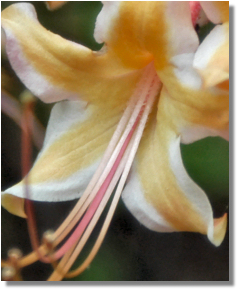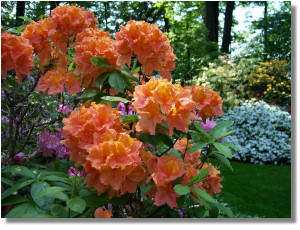

|

ARBORETUM PICTURE OF THE WEEK DIRECT ARBORETUM SUPPORT PRIVATE
SUPPORT GROUPS
|
|
||||||||
Whole Campus, Fern Valley, Asian, Conifer, and Bonsai Collections |
Arboretum Virtual Tour for Kids! |
Check back often for info on its reopening |
View plants developed by arboretum scientists and find one that's right for you! |
Check out what is in bloom. |
at the U.S. National Arboretum. |
 EDUCATION
EDUCATION
Walk & Talk: Azalea Collection Tours
Walk through our collection of tens of thousands of brilliant blooming azaleas and witness one of Washington's premier spring attractions. The network of rustic woodland trails allows you to view the blossoms at close range, while providing sweeping views of the arboretum grounds. Fee $19. Registration is required.
Come into the lobby to see this exhibit of striking images by Andrea Ottesen, plant scientist and award-winning photographer. Ottesen’s unique style joins together art, science and photography to create plant portraits which highlight the unique qualities of each plant, giving a modern spin to the traditional style of scientific illustration. This exhibit focuses on plants native to the Eastern United States. Free admission. |
|
Three-Flower Maple (Acer triflorum) - Three Times a Charmer Acer triflorum, the three-flower maple, is interesting all year round;
but in three seasons it truly shines, and has almost limitless landscape use. In late autumn, the leaves color spectacularly, ranging from golden yellow to
pumpkin orange bordering on red, rivaling even the famous sugar maple (Acer saccharum) for brilliance. In winter, the tree displays
exfoliating bark in shades of cream, beige, pearly gray, or brown with orange undertones,
and a waxy sheen especially on younger stems and trunks. |
| |
|
USDA Grant Awarded for Development of a Microarray System A USDA National Research Initiative grant was recently awarded to Dr. John Hammond and Dr. Ramon Jordan of the U.S.
National Arboretum's Floral and Nursery Plants Research Unit, in collaboration with scientists at several other institutions.
The grant is for $999,735 over a period of three years, with the goal of developing the capability to detect and identify plant
viruses, from any type of plant, to at least the viral genus level. Most existing methods of virus detection are either virus-specific, or detect a number of related viruses within one group,
and are unable to detect viruses of other taxonomic groups. In contrast, the microarray will consist of thousands of oligonucleotides
(short DNA ‘probes’), each derived from nucleic acid sequences conserved between the genomes (RNA or DNA) of members of a particular
taxonomic group, or between isolates of a particular viral species. These ‘probes’ are spotted in an array to a support surface.
Total nucleic acids from plants are ...
Read Full Story |
|
Arboretum Information || Events & Education || Gardens & Horticulture || Research Activities Support the Arboretum || New Plant Introductions || USDA Plant Hardiness Zone Map || Comments Search Our Site
3501 New York Avenue, NE; Washington, D. C. 20002-1958 Tel: 202-245-2726 Fax: 202-245-4575
Beltsville Agricultural Research Center of the Agricultural Research Service of the U.S. Department of Agriculture
URL= http://www.usna.usda.gov *###* |